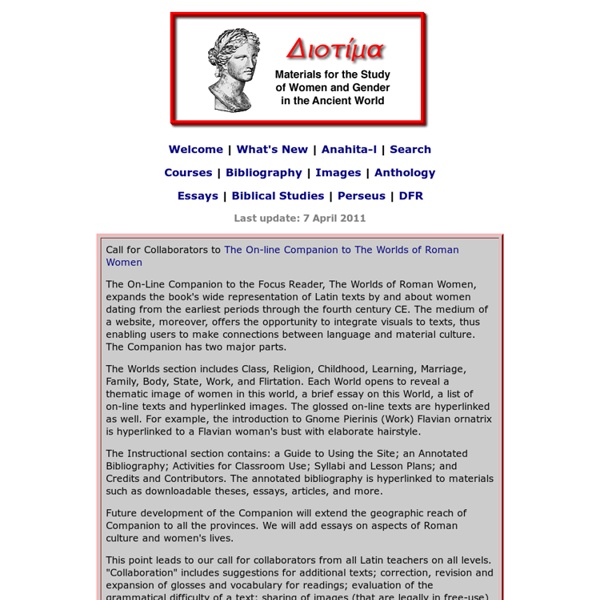Maecenas: Images of Ancient Greece and Rome
408,330 visitors before 21 March, 2002, visitors since then Images are copyrighted, but may be used for non-commercial purposes. Click here to see the images If the search engine is out of service, you can use back-up search engine.
Herodotus Timemap
Book 1, Ch. 1 This is the display of the inquiry of Herodotus of Halicarnassus, so that things done by man not be forgotten in time, and that great and marvelous deeds, some displayed by the Hellenes, some by the barbarians, not lose their glory, including among others what was the cause of their waging war on each other.The Persian learned men say that the Phoenicians were the cause of the dispute. These (they say) came to our seas from the sea which is called Red, and having settled in the country which they still occupy, at once began to make long voyages.
DHQ: Digital Humanities Quarterly: Digital Geography and Classics
Changing the Center of Gravity: Transforming Classical Studies Through Cyberinfrastructure2009Volume 3 Number 1 Abstract The authors open by imagining one possible use of digital geographic techniques in the context of humanities research in 2017. They then outline the background to this vision, from early engagements in web-based mapping for the Classics to recent, fast-paced developments in web-based, collaborative geography. The article concludes with a description of their own Pleiades Project ( which gives scholars, students and enthusiasts worldwide the opportunity to use, create and share historical geographic information about the Greek and Roman World in digital form.
Home - Classics - LibGuides at Credo Reference
Credo LibGuides can be linked to from your institution's webpage. For LibGuides subscribers, these guides may be freely copied and modified to create or supplement your own LibGuides. Learn how to copy a LibGuide. When clicking on the links, your Credo account is accessed by IP authentication or through your institution's proxy server.
Warburg Institute digital copy antiquities
Catalogue Articles You are not logged in | My saved items (0 items) | Login Give Feedback Explore Related Searches Advanced Search Results 1 - 25 of 30 for Warburg Institute digital copy antiquities
Classical Reception Studies Network
The Classical Reception Studies Network (CRSN) aims to facilitate the exchange of information and to encourage collaboration in the field of classical reception studies by bringing together departments and individuals from across the world. Classical Reception Studies is the inquiry into how and why the texts, images and material cultures of Ancient Greece and Rome have been received, adapted, refigured, used and abused in later times and often other places. For more information on the Network and its history, please go to the Network page which explains who we are and what we do. The Events section lists current and future Classical Reception conferences, seminars, workshops and performances.
LacusCurtius — Smith's Dictionary of Greek and Roman Antiquities
LacusCurtius Educational Resource: a Selection of Articles from A 19th-Century Classical Encyclopaedia William Smith, D.C.L., LL.D.: A Dictionary of Greek and Roman Antiquities John Murray, London, 1875.
Collections - Dina Goldstein
On | Off Collections Modern Girl Gods of Suburbia Fallen Princesses In The Dollhouse
iconiclimc
Simple search (?)Boolean search (?) 51577 images in the database
Benthos: Digital Atlas of Ancient Waters
Introducing Benthos AWMC is pleased to introduce a beta version of Benthos: Digital Atlas of Ancient Waters; at present this project is in its most preliminary changes, but as always AWMC welcomes feedback from the community. Aims



